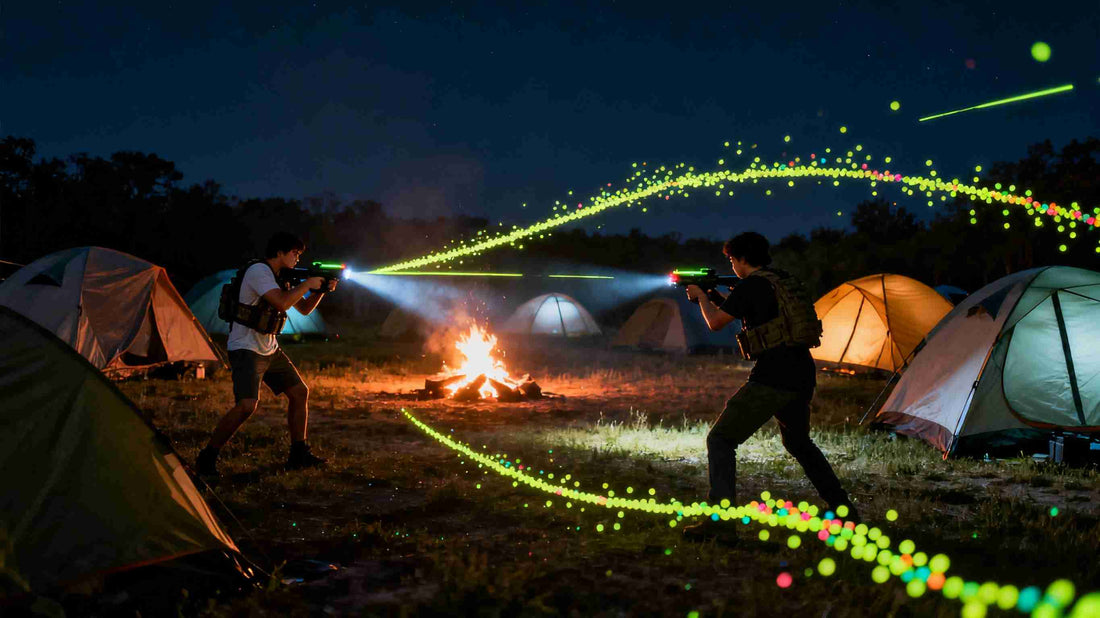
Beginner’s Guide to Gel Blaster Water Beads
Share
If you’re new to gel blasters, you might be surprised by how much the tiny water beads impact your gameplay. These squishy projectiles aren’t just “accessories”—they’re the heart of safe, fun shooting. But for beginners, questions quickly pile up: How do I soak them correctly? What size should I buy? Can I reuse them? This guide breaks down everything you need to know about gel blaster water beads, from basic science to hands-on tips, so you can avoid mistakes and get the most out of your gear.
1. First Things First: What Are Gel Blaster Water Beads?
Before you start soaking, let’s cover the basics—understanding what water beads are will help you use them better.
Gel blaster water beads (also called “gel ammo” or “hydrogel beads”) are small, spherical projectiles made from superabsorbent polymers (SAPs)—most commonly sodium polyacrylate, a food-grade, non-toxic material used in products like baby diapers and gardening soil.
In their dry state, they’re tiny: usually 2–3mm in diameter (about the size of a pinhead) and hard, like tiny plastic pellets. But when soaked in water, they undergo a dramatic transformation: they absorb 300–500 times their weight in water, swelling to 7–10mm (the size of a small marble or pea). The result is a soft, flexible hydrogel bead that’s 95% water and 5% polymer—safe enough to shoot at friends without causing harm, but sturdy enough to fly from your blaster.
Key Specifications (Specs) Beginners Need to Know
Not all beads are the same—size matters most, as it must match your gel blaster’s barrel:
- 7–8mm beads: The most common size, designed for standard gel blasters (pistols, rifles, and SMGs). If you’re unsure, start here—they work with 90% of beginner-friendly blasters.
- 9–10mm beads: Larger, for high-powered gel blasters (like sniper rifles or upgraded models). Using these in a standard blaster will cause jams.
- Color: Purely cosmetic—clear, blue, green, or neon beads all perform the same. Avoid “glow-in-the-dark” or “scented” beads for beginners, as they often have extra additives that affect absorption.
2. Step-by-Step: How to Soak Water Beads (The Right Way)
Soaking is the most critical step for beginners—and the easiest to mess up. Over-soaked beads break in your blaster; under-soaked ones are too hard and risky. Follow this process for perfect beads every time:
What You’ll Need
- Dry water beads (100–200 per hour of play, depending on your blaster’s capacity)
- A large bowl or bucket (at least 2x the volume of the beads—they expand a lot!)
- Room-temperature tap water (distilled works too, but tap is fine for beginners)
- A colander or sieve (for draining excess water)
- A clean towel (for gently patting beads dry, optional)
Step 1: Measure the Beads
Don’t guess—use a measuring cup. For most beginners, ¼ cup of dry beads makes enough for 1–2 hours of play (they’ll fill a 2–3 cup bowl once swollen). Pouring too many dry beads will lead to overcrowding, and some won’t expand evenly.
Step 2: Add Water
Cover the dry beads with 2–3 inches of water (they need space to expand). The water should be room-temperature (18–25°C)—avoid hot water (it damages the polymer, making beads brittle) or cold water (slows absorption to 6+ hours).
Step 3: Wait (And Don’t Peek Too Soon!)
Set a timer for 3–4 hours. Resist the urge to stir or squeeze the beads early—this can deform them. After 3 hours, check a few:
- A properly soaked bead is soft but firm (like a ripe grape) and holds its spherical shape.
- If it’s still hard or has a white “core” in the center, soak for another 30–60 minutes.
- If it’s mushy, tears easily, or sticks to your fingers, it’s over-soaked—discard these (they’ll jam your blaster).
Step 4: Drain and Sort
Once soaked, pour the beads into a colander to drain excess water (don’t leave them sitting in water—this causes over-softening). Then, take 1–2 minutes to sort:
- Remove any beads that are too small (under 6mm) or too large (over 11mm)—these cause jams.
- Pick out broken or misshapen beads—they won’t fly straight.
Pro Tip for Beginners
If you’re short on time, use a “quick-soak” trick: Use lukewarm water (not hot!) and stir the beads gently every 30 minutes. This cuts soaking time to 2–2.5 hours—but never skip the final check for softness.
3. How to Choose Quality Water Beads (Avoid Cheap Junk)
Not all water beads are created equal. Cheap, generic beads from discount stores often have uneven sizes, poor absorption, or even toxic additives. Here’s how beginners can spot quality beads:
1. Check the Material
Look for beads labeled “food-grade SAP” or “non-toxic.” Avoid beads with a strong chemical smell—this is a red flag for harmful additives. Trusted brands (like Hdrason, GelSoft, or Valken) clearly list their materials on the packaging.
2. Test for Uniformity
Pour a handful of dry beads onto a flat surface. Quality beads are almost identical in size (no huge gaps between small and large pellets). Uneven dry beads mean unevenly swollen beads, which lead to jams.
3. Avoid “Bargain Bulk” Packs (At First)
5,000-bead packs seem like a good deal, but they’re often low-quality. For beginners, start with a small pack (500–1,000 beads) from a reputable brand. Once you know what works, you can buy in bulk.
4. Match to Your Blaster
As we mentioned earlier, size is non-negotiable. Check your blaster’s manual—most beginner models list the recommended bead size (usually 7–8mm). If you don’t have the manual, measure the barrel’s inner diameter with a ruler: it should be 1–2mm larger than the swollen bead (e.g., an 8mm barrel needs 7mm beads).
4. Storage & Reuse: Make Your Beads Last Longer
Beginners often waste beads by letting them dry out or mold. With proper storage, you can reuse soaked beads for days—and keep dry beads fresh for months.
Storing Soaked Beads (Short-Term)
If you have leftover soaked beads:
- Pat them gently with a towel to remove excess moisture (don’t squeeze!).
- Put them in an airtight container (a plastic Tupperware or mason jar works) and add 1–2 tablespoons of water (just enough to keep them moist, not submerged).
- Store in the fridge (extends life to 7–10 days) or at room temperature (3–5 days).
Warning: Don’t leave soaked beads in a hot car or direct sunlight—they’ll dry out or grow mold.
Reusing Dried-Out Beads
If your soaked beads dry out (they’ll shrink back to 2–3mm and harden), you can re-soak them! But note:
- They’ll absorb water more slowly the second time (add 30–60 minutes to soaking time).
- Performance drops slightly—reused beads may be less uniform or softer. Use them for casual play, not competitive games.
Storing Dry Beads (Long-Term)
Unused dry beads last 6–12 months if stored right:
- Keep them in their original sealed bag, or transfer to a dry, airtight container.
- Store in a cool, dark place (avoid basements or bathrooms—moisture causes clumping).
- If they clump together, break them apart with your fingers before soaking (clumps won’t expand evenly).
5. Common Mistakes Beginners Make (And How to Fix Them)
Even with the best guide, beginners slip up. Here are the top 3 mistakes and how to fix them:
Mistake 1: Over-Soaking Beads
Problem: Beads are mushy, stick to the blaster’s barrel, or break mid-shot.
Fix: Set a timer and check beads at the 3-hour mark. If you over-soak, drain them and let them sit on a towel for 15–20 minutes—they’ll firm up slightly.
Mistake 2: Using the Wrong Size Beads
Problem: Beads get stuck in the barrel (jamming) or fall out of the magazine.
Fix: Measure your blaster’s barrel and buy matching beads. If you’re stuck with the wrong size, use a sieve to separate usable beads (e.g., sift 7mm beads from a mixed pack for a standard blaster).
Mistake 3: Ignoring Cleanup
Problem: Dried beads leave a crumbly mess, or mold grows in leftover beads.
Fix: After play, sweep or vacuum any dry bead crumbs (they’re biodegradable, but still messy). Throw away any moldy, soaked beads—don’t re-soak them.
6. Safety & Environmental Tips for Beginners
Water beads are safe, but they need to be used responsibly:
Safety First
- Always wear eye protection: Even soft beads can hurt if they hit your eye. Use ANSI-approved safety goggles (not sunglasses or regular glasses).
- Keep away from small kids/pets: Soaked beads are a choking hazard for toddlers or small animals. Store beads out of reach.
- Don’t shoot at faces or sensitive areas: Stick to shooting at torsos or limbs—this keeps play fun for everyone.
Environmental Responsibility
- No littering: Soaked beads biodegrade in 4–6 weeks outdoors, but don’t leave them in parks or public spaces (they can confuse wildlife). Pick up any stray beads after play.
- Don’t pour beads down drains: Swollen beads can clog pipes. Throw unused, soaked beads in the trash (they’ll dry out and decompose).
Final Thoughts for Beginners
Gel blaster water beads are simple once you get the hang of them—but taking the time to soak, sort, and store them correctly makes all the difference. Start small, follow the steps, and don’t be afraid to experiment (e.g., try different brands to find your favorite). With this guide, you’ll be shooting smoothly and safely in no time—enjoy the fun!
